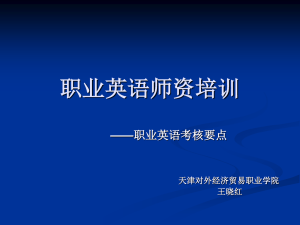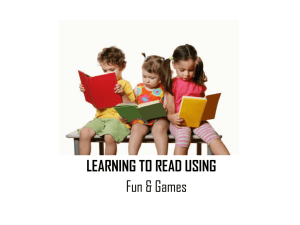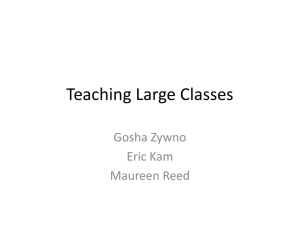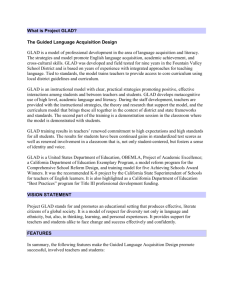GLAD Basics – PowerPoint
advertisement
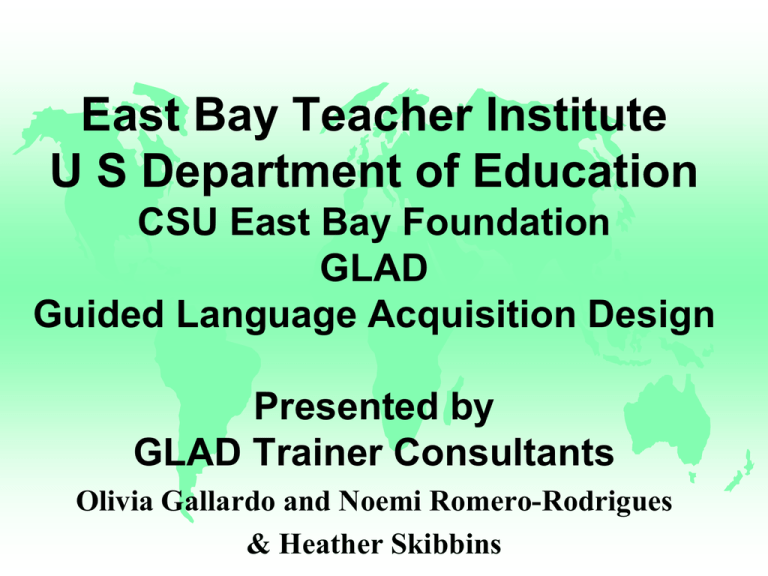
East Bay Teacher Institute U S Department of Education CSU East Bay Foundation GLAD Guided Language Acquisition Design Presented by GLAD Trainer Consultants Olivia Gallardo and Noemi Romero-Rodrigues & Heather Skibbins What is Project GLAD (Guided Language Acquisition Design) Project GLAD™ is a curricular model of professional development dedicated to building academic language and literacy for all students; especially English learners. Objectives Review the Theoretical Base for Project GLAD Introduce the curriculum model as an integrated, balanced language and literacy approach to language acquisition. Model strategies that fully integrate listening, speaking, reading and writing in a “language functional environment” History of Project GLAD 1980’s 1990 Developed for Newcomer EL Students by Marcia Brechtel and Linnea Haley in Fountain Valley, CA Designated Exemplary Program by the State 1991 Designated Program of Academic Excellence by the U.S. Department of Education 2004 Identified as model PD for Title III Today Used in over 100’s of districts and schools internationally, over 100 Key trainers across the country GLAD Coaching Model Theoretical Framework - research and theory of model based on Joyce and Showers A. Two day workshop B. Four day in classroom demonstration with coaching (a.m.) C. Four days for grade-level, standards based planning with coaching and assistance from GLAD trainers (p.m.) RESEARCH: HOW LONG DOES IT TAKE ENGLISH LANGUAGE LEARNERS TO LEARN ENGLISH? 2 years 5 - 7 years Conversational Academic Language FLUENCY B.I.C.S. Language PROFICIENCY C.A.L.P. Basic Interpersonal Communication Skills Common Academic Language Proficiency Stages of Language Acquisition ELD Standards PRE PRODUCTION no verbal production EARLY PRODUCTION one/two word responses SPEECH EMERGENCE simple sentences INTERMEDIATE FLUENCY more complex sentences FLUENT BEGINNING EARLY INTERMEDIATE INTERMEDIATE EARLY ADVANCED ADVANCED Negotiation for Meaning Example of zone of proximal development in action: • first, no one thought he could learn • second, he learned with his group • third, he was able to learn alone Memorizing a list of words vs. Knowing what to do with them Definitions only have meaning if you sit and think about it, talk about it, and act upon it. Vygotsky (Adapted by: Project GLAD) Primary Language Knowledge and skills transfer across languages Longitudinal studies have shown primary language use accelerates English acquisition Parents can support literacy through primary language use Cummins Ramirez Collier/Thomas Wong Fillmore Primary Language Transferability •Concepts •Cognates •Reading and writing process •Habits of Mind, identity, language and culture What is Culture? Cultural Connections Validation of home language and culture Strengthening connections between home and school Critical pedagogy Lily Wong Fillmore Alma Joan Flor Ada Wink Funds of Knowledge “This totality of experiences, the cultural structuring of the households, whether related to work or play, whether they take place individually, with peers, or under the supervision of adults, helps constitute the funds of knowledge children bring to school.” (Moll & Greenberg, 1990) 10/2 What does this information about primary language and culture make you think about? Brain Research Metacognition 10/2 and Costa Patterning & Language Kovalik Right/Left Brain Rico Window Multiple Triune Intelligences Brain Gardner Wolfe Logical/Mathematical graphic organizers problem solving Verbal/ Linguistic Interpersonal Visual/Spatial TOOLBOX storytelling journal writing drama body language drawing, painting mind-mapping Multiple Intelligences Intrapersonal Body/ Kinesthetic giving feedback division of labor reflection metacognition Musical/Rhythmic rhythmic patterns musical performance Reading & Writing A Balanced Literacy Approach Philosophical Foundations Language Functional Environment Writer’s Workshop Effective & Meaningful Writing Strategies ELL Framework for Reading Goodman/Cambourne & Smith Traill Calkins UCI & Graves Writing Project Shefelbine Shefelbine’s Framework for Reading Motivation (success, pleasure, relevance) Decoding Word Fluency Recognition Strategies Concepts of print Phoneme Awareness Sight Words Automaticity Comprehension Academic Comprehension Language Strategies Background Knowledge Vocabulary Syntax and Text Structure Comprehension Monitoring (Re)organizing Text To begin with the end in mind means to start with a clear understanding of your destination. It means to know where you’re going so that you better understand where you are now so that the steps you take are always in the right direction… Stephen Covey 10/2 How does this approach to planning instruction fit in with your experience? Strategies-Walk the Walls Five Components of GLAD Focus and Motivation Input Guided Oral Practice Reading/Writing Closure/Assessment Focus and Motivation Purpose: Motivation - To hook students Diagnostic - To find out what students know and where we need to build background knowledge When: At beginning of unit Throughout to motivate/sustain interest Strategies Three Standards Super Scientist Awards Observation Charts Cognitive Content Dictionary Inquiry Chart Big Book Realia Input Purpose: Direct teaching of concepts Comprehensible Input and Output Done whole class – “teach to the highest, review to the lowest” When: Mostly at beginning of unit Reprocessed throughout the unit Strategies Graphic Organizers – – Tree of life – Timeline – World Map Pictorial Input Chart Comparative Input Chart ELD Review Narrative Input Guided Oral Practice Purpose: To build academic language Opportunity to practice using vocabulary in risk-free environment Foster habits of positive interaction Provide opportunities for academic discourse When: Throughout the unit Strategies T-Graph Team Points Chants/Poetry Booklet Picture File Cards Exploration Report Sentence Patterning Chart – Games/add-ons/chants Reading and Writing The curriculum model provides a natural scaffold where students complete learning tasks in this order: “First you do, then we do, then I do…” 1. Whole class 2. Small group 3. Individual “Stress the Joy and purpose of reading and writing” Brechtel Strategies Non-Rhyming/Free- form Poetry Expert Groups Process Grid Coop Strip Paragraph EL Review Story Map Learning Logs Interactive Journals Writer’s Workshop Team Tasks Portfolios Assessment and Evaluation Any student can hit a target if they can see the target, and it holds still. Our kids don’t know what they need to learn, how they’re going to be assessed, and what they need to do to get there. Sagor Education is Based on Relationships “The starting point for understanding why students choose to engage academically or, alternatively, withdraw from academic effort is to acknowledge that human relationships are at the heart of schooling.” Jim Cummins Effective Interventions For a real change to occur, educational interventions must be oriented toward empowerment -toward allowing students to feel a sense of efficacy and control over what they are committed to doing in the classroom and in their lives outside the school. Jim Cummins Who does GLAD benefit? English Learners Standard English Learners GATE Students Struggling Readers Unmotivated Students Visual, Kinesthetic, & Auditory Learners Multiple Intelligences THAT IS--ALL STUDENTS! 39
